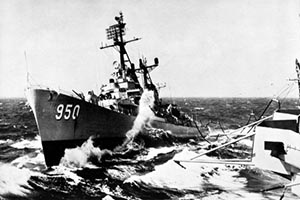 |
Tonkin Gulf IntrusionBy Allen Meece
Tonkin Gulf Intrusion is an excerpt from "The Abel Mutiny" by Allen Meece. "NOW GENERAL QUARTERS! GENERAL QUARTERS! ALL HANDS MAN YOUR BATTLE STATIONS FOR SURFACE ACTION! THIS IS NOT A DRILL, I REPEAT, THIS IS NOT A DRILL!" There is a bright wash of land only seven miles away on radar and you ask a nearby officer, "What is that?" He looks at the blip and ignores your question. You deduce that it is an officer-level secret and that you're where you shouldn't be, on a menacing warship seven miles from the shore of northern Vietnam. Combat Information Center is manned with an air of competency. The radarman with an Elvis Presley hairstyle is drawing a surrogate battle scene that will be these men's only experience of the attack, unless, that is, one of the enemy dots gets within torpedo range and explodes the ship and this whole room descends below the surface of the Gulf of Tonkin. That could happen but don't think about it or you won't stay calm. If you don't stay calm you can't concentrate. If you don't do your job well, you'll die. It's simple. This is combat. The tactical board shows a squadron of five contacts nine miles away and closing at an impressive speed of fifty knots. The room sways and lurches in the destroyer's wild flight at flank speed, a mere thirty knots. The officer on the other side of your floor-mounted radar console receives instructions and points to the nearest contact and says, "Designate target one to fire control." Your radar screen displays an electronic target hook that you can manipulate with a control stick to encircle that radar contact which appears most threatening to the ship. You snare the contact and say into the phones, "Fifty one, Combat, now designating target one." "Fifty one, target one, aye." Director fifty one's electronic hook moves to the blip and clings to it with automatic tracking. The gun director has acquired target and is locked-on. "Fifty one, ready to shoot." "Good work, fire control. That you, Kaiser?" "Kaiser, aye." "What's happening is this. We've got five quick-boats on radar. There's another tin can out here with us that's taking the two western-most contacts and we're taking the three closer ones." "Fifty one aye," is the terse reply from Kaiser who has work to do. "Commence firing," says the XO, passing the order from the captain on the open bridge. No one's heard the term before. They're not sure what to do and nothing happens. "Are we supposed to shoot 'em?" asks Kaiser incredulously over the phones. "Wait one." You ask the ensign, "Are we supposed to shoot these contacts?" Now the ensign's doubtful. He turns around and looks at the executive officer. The XO understands the question: Should a ship in peacetime be killing the crew and sinking the boats of another nation? The XO nods yes. The ensign regains his military composure and says, "You heard that order, commence firing." "Kaiser?" "Yes?" "Shoot the target." That sounds better. "Shooting the target" is something Kaiser knows how to do from gunnery exercises. That phrase ignores the death it's going to bring. BANG! A shell is fired with intent to kill. Now you're in a life or death struggle. Your country transported you to a place where you shouldn't have been and forced you to defend your life in order to get out of there. And like any war excuse, the Tonkin Gulf Incidents were lies. We were not frivolously attacked on the high seas as the corporate media parroted the establishment lie. Our DeSoto Patrols had intruded NVN's sovereign coastal waters many times. Finally, war was started. It didn't end until commercial fortunes were made while 58,178 American military men and women died. Allen Meece joined the Navy in 1962 to see the world and "protect democracy." He was made a fool. His destroyer was in the third Tonkin Gulf Incident of September 18th of 1964. He authored the Tonkin Gulf naval war novella called "The Abel Mutiny" which is available from Amazon.com.
|


